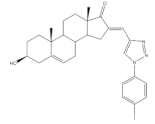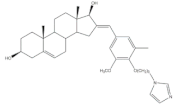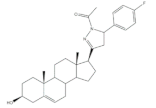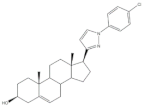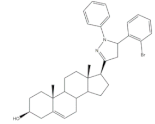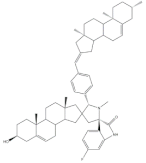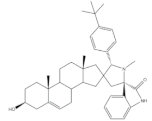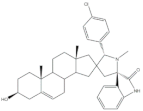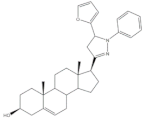Steroids constitute a unique class of chemical compounds, playing an important role in physiopathological processes, and have high pharmacological interest. Due to their straightforward preparation and intrinsic chemical reactivity, steroidal arylidene derivatives are important synthetic intermediates for the preparation of other compounds, particularly bearing heterocyclic systems, in addition to their relevant bioactivity with potential pharmacological interest.
- steroids
- arylidenesteroids
- aldol condensation
- bioactivity
- heterocycles
1. Introduction
Steroids are natural products that share a 17-carbon-atom skeleton and are composed of four fused rings: three cyclohexanes (A, B, and C rings) and one cyclopentane (D ring). These compounds vary on the attached functional groups, their position, and configuration [1]. In addition, steroids represent a unique class of chemical products, playing an important role in several biological processes, being the most important group of regulatory and signaling molecules [2][3]. Usually, steroids are lipophilic and readily enter cells, being able to interact with nuclear receptors as well as with membrane proteins. Therefore, they are associated with most physiological functions and pathological conditions. In addition, due to their low toxicity, less vulnerability to multidrug resistance, and high bioavailability [4][5][6][7][8], steroid-based therapeutic drugs have called attention to the scientific academia and industry for a long time.
Steroids are natural products that share a 17-carbon-atom skeleton and are composed of four fused rings: three cyclohexanes (A, B, and C rings) and one cyclopentane (D ring). These compounds vary on the attached functional groups, their position, and configuration [1]. In addition, steroids represent a unique class of chemical products, playing an important role in several biological processes, being the most important group of regulatory and signaling molecules [2,3]. Usually, steroids are lipophilic and readily enter cells, being able to interact with nuclear receptors as well as with membrane proteins. Therefore, they are associated with most physiological functions and pathological conditions. In addition, due to their low toxicity, less vulnerability to multidrug resistance, and high bioavailability [4,5,6,7,8], steroid-based therapeutic drugs have called attention to the scientific academia and industry for a long time.
Due to their relevance, several modified steroids have been synthesized and biologically evaluated, being verified that their relevant pharmacological properties depend on the structural features of the steroidal four-ring skeleton and side-chain [5][9]. In fact, even a minor structural variation on the steroidal nucleus can lead to marked changes in their physiological activity [10]. Therefore, aiming to improve their pharmacological properties and/or develop compounds with different bioactivities, structural modifications of steroids have been an important focus of research over the last decades [11][12][13][14][15].
Due to their relevance, several modified steroids have been synthesized and biologically evaluated, being verified that their relevant pharmacological properties depend on the structural features of the steroidal four-ring skeleton and side-chain [5,14]. In fact, even a minor structural variation on the steroidal nucleus can lead to marked changes in their physiological activity [15]. Therefore, aiming to improve their pharmacological properties and/or develop compounds with different bioactivities, structural modifications of steroids have been an important focus of research over the last decades [16,17,18,19,20].
2. Synthetic Approaches to Prepare Arylidene Steroidal Derivatives
Arylidenesteroids are usually obtained through an aldol condensation between a steroid and an aldehyde. In an aldol condensation, an enol or enolate reacts with a carbonyl in the presence of an acid or base catalyst to form a β-hydroxyaldehyde or a β-hydroxyketone, followed by dehydration to afford a conjugated enone [16]. In general, the reactions to prepare arylidenesteroids occur at room temperature (RT), under basic catalysis, and the solvent is, in most cases, methanol (MeOH) or ethanol (EtOH) (
Arylidenesteroids are usually obtained through an aldol condensation between a steroid and an aldehyde. In an aldol condensation, an enol or enolate reacts with a carbonyl in the presence of an acid or base catalyst to form a β-hydroxyaldehyde or a β-hydroxyketone, followed by dehydration to afford a conjugated enone [46]. In general, the reactions to prepare arylidenesteroids occur at room temperature (RT), under basic catalysis, and the solvent is, in most cases, methanol (MeOH) or ethanol (EtOH) (
).

Figure 1.
Claisen–Schmidt condensation to prepare 16
E
- and 21
E
-arylidenesteroids.
3. Bioactivity of 2- and 16E-arylideneandrostane Derivatives
The 16
E-arylideneandrostane steroidal skeleton has emerged as a relevant template to develop potential anticancer agents. In addition to cytotoxic effects, several studies reported other biological activities, such as aromatase inhibition, anti-inflammatory, neuroprotective and skeletal muscle relaxing activities and tissue-selective androgen receptor modulator effects [17][18][19]. A selection of the most relevant 16
-arylideneandrostane steroidal skeleton has emerged as a relevant template to develop potential anticancer agents. In addition to cytotoxic effects, several studies reported other biological activities, such as aromatase inhibition, anti-inflammatory, neuroprotective and skeletal muscle relaxing activities and tissue-selective androgen receptor modulator effects [38,57,58]. A selection of the most relevant 16
E
-arylideneandrostane derivatives is presented in
.
Table 1.
E
4. Bioactivity of 21E-arylidenepregnene Derivatives
Arylidenesteroidal derivatives of progesterone and pregnenolone and other similar pregnanes constitute a smaller group than arylideneandrostanes, and they have mainly been studied as potential antitumoral agents. Of these, the most potent arylidenepregnene derivatives reported until now are presented in
.
Table 2.
E
.
| Compound | Bioactivity Data | Ref. | ||
|---|---|---|---|---|
 | 15 |
Antiproliferative activity (IC | 50 | μM) | [28] | [69] | ||||||
| Cell line | 15 | |||||||||||
| HCT-15 | 0.81 | |||||||||||
 | 16 |
Antiproliferative activity (IC | 50 | μM) | [28] | [69] | ||||||
| Cell line | 16 | |||||||||||
| MCF-7 | 0.60 | |||||||||||
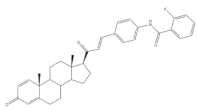 | 17 |
Antiproliferative activity Growth inhibition (%) |
[17] | [38] | ||||||||
| Cell line | 17 | Cis (+) | ||||||||||
| HeLa | 58 | 99 | ||||||||||
| MCF-7 | 64 | 88 | ||||||||||
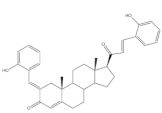 | 18 |
Antimicrobial activity Zone of inhibition (mm) |
[29] | [76] | ||||||||
| Gram positive | 18 | AMP (+) | ||||||||||
| Streptococcus pneumoniae | 30 | 20 | ||||||||||
| Staphylococcus aureus | 24 | 22 | ||||||||||
5. Bioactivity of 16E-arylidenoestrone and 16E-arylidenoestradiol Derivatives
It is well known that estrogenic hormones have an important contribution to estrogen-dependent diseases, being breast cancers primarily initiated and stimulated by estrogens the majority of these conditions [30]. Consequently, the structural modification of estrone and estradiol in different positions to prepare bioactive compounds in this context has been the focus of intensive research.
It is well known that estrogenic hormones have an important contribution to estrogen-dependent diseases, being breast cancers primarily initiated and stimulated by estrogens the majority of these conditions [77]. Consequently, the structural modification of estrone and estradiol in different positions to prepare bioactive compounds in this context has been the focus of intensive research.
Table 3.
E
| Compound | Bioactivity Data | Ref. | |
|---|---|---|---|
Of these prepared compounds, steroid
21
(
) showed a potent antiangiogenic activity. Moreover, further studies suggested that this compound suppresses the tumor growth in about 50% in human breast cancer (MCF-7) xenograft models without relevant side effects. The action mechanism studies suggested that steroid
21 targeted the epithelial to mesenchymal transition process in MCF-7 cells and inhibited human umbilical vein endothelial cells (HUVEC) migration, contributing to angiogenesis interruption [33].
targeted the epithelial to mesenchymal transition process in MCF-7 cells and inhibited human umbilical vein endothelial cells (HUVEC) migration, contributing to angiogenesis interruption [85].
6. Importance of Steroidal Arylidene Derivatives as Synthetic Intermediates of Bioactive Molecules
In addition to their biological activity, steroidal arylidenes are also versatile synthetic intermediates in the preparation of other bioactive structures. In fact, these steroids have been used in the introduction of diverse chemical groups present in bioactive compounds, such as oximes, hydroxyl and hydrazones [28][34][35][36][37], and are particularly useful in several heterocyclization reactions. In this context, over the years, a large number of bioactive heterocyclic steroidal derivatives have been synthesized, and some of them are already being clinically used [38][39]. Interestingly, diverse heterocyclic compounds, including arylpyrazolines and pyrazoles, arylpyrimidines, oxindoles, pyridones and pyridines as well as spiro-pyrrolidines were prepared from arylidenesteroids [4][13][40][41][42][43][29][37][44][45][46][47][48][49][50][51][52][53][54]. The most promising steroidal derivatives prepared from arylidenesteroids that have been reported until the moment are presented in
In addition to their biological activity, steroidal arylidenes are also versatile synthetic intermediates in the preparation of other bioactive structures. In fact, these steroids have been used in the introduction of diverse chemical groups present in bioactive compounds, such as oximes, hydroxyl and hydrazones [69,90,91,92,93], and are particularly useful in several heterocyclization reactions. In this context, over the years, a large number of bioactive heterocyclic steroidal derivatives have been synthesized, and some of them are already being clinically used [94,95]. Interestingly, diverse heterocyclic compounds, including arylpyrazolines and pyrazoles, arylpyrimidines, oxindoles, pyridones and pyridines as well as spiro-pyrrolidines were prepared from arylidenesteroids [4,18,42,49,53,56,76,93,96,97,98,99,100,101,102,103,104,105,106]. The most promising steroidal derivatives prepared from arylidenesteroids that have been reported until the moment are presented in
.
Table 4.
7. Summary
Steroids constitute an important group of structurally related natural, semi-synthetic, and synthetic compounds with remarkable functions, including regulatory and signaling activities. In the last three decades, steroidal arylidene derivatives have been prepared and screened for a range of biological activities and used as synthetic intermediates, with special attention to bioactive heterocyclic steroids. In conclusion, due to the straightforward synthesis of arylidenesteroids and their bioactivity, as well as the inherent chemical reactivity of α,β-unsaturated ketones, useful in the preparation of other derivatives, this class of compounds has been of high interest in the last years.

